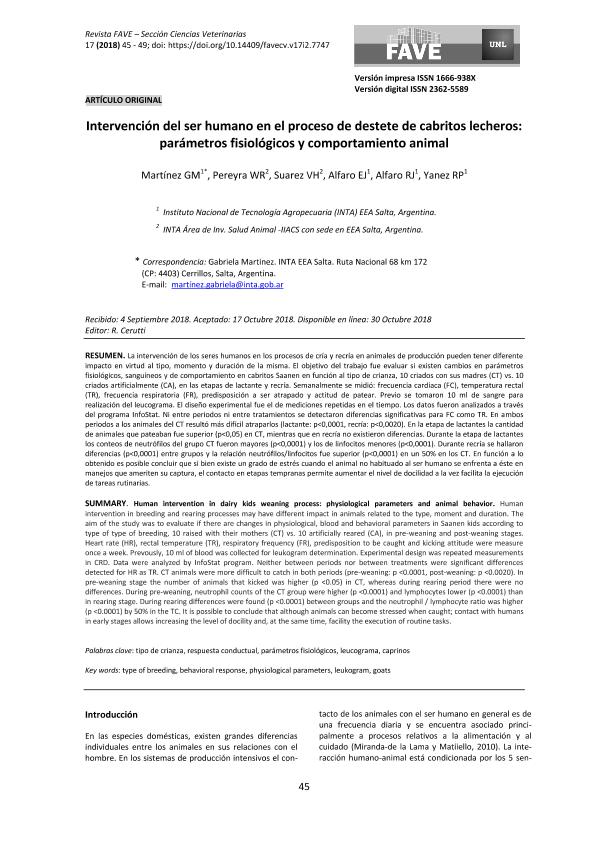Mostrar el registro sencillo del ítem
dc.contributor.author
Martinez, Gabriela Marcela
dc.contributor.author
Pereyra, Walter Rodrigo

dc.contributor.author
Suarez, Víctor Humberto

dc.contributor.author
Alfaro, Emilio José
dc.contributor.author
Alfaro, Rodolfo José
dc.contributor.author
Yanez, Ramón Arturo
dc.date.available
2021-12-20T17:00:22Z
dc.date.issued
2018-10-30
dc.identifier.citation
Martinez, Gabriela Marcela; Pereyra, Walter Rodrigo; Suarez, Víctor Humberto; Alfaro, Emilio José; Alfaro, Rodolfo José; et al.; Intervención del ser humano en el proceso de destete de cabritos lecheros: parámetros fisiológicos y comportamiento animal; Universidad Nacional del Litoral. Facultad de Ciencias Veterinarias; Fave. Sección Ciencias Veterinarias; 17; 2; 30-10-2018; 45-49
dc.identifier.issn
1666-938X
dc.identifier.uri
http://hdl.handle.net/11336/149029
dc.description.abstract
La intervención de los seres humanos en los procesos de cría y recría en animales de producción pueden tener diferente impacto en virtud al tipo, momento y duración de la misma. El objetivo del trabajo fue evaluar si existen cambios en parámetros fisiológicos, sanguíneos y de comportamiento en cabritos Saanen en función al tipo de crianza, 10 criados con sus madres (CT) vs. 10 criados artificialmente (CA), en las etapas de lactante y recría. Semanalmente se midió: frecuencia cardiaca (FC), temperatura rectal (TR), frecuencia respiratoria (FR), predisposición a ser atrapado y actitud de patear. Previo se tomaron 10 ml de sangre para realización del leucograma. El diseño experimental fue el de mediciones repetidas en el tiempo. Los datos fueron analizados a través del programa InfoStat. Ni entre periodos ni entre tratamientos se detectaron diferencias significativas para FC como TR. En ambos periodos a los animales del CT resultó más difícil atraparlos (lactante: p<0,0001, recría: p<0,0020). En la etapa de lactantes la cantidad de animales que pateaban fue superior (p<0,05) en CT, mientras que en recría no existieron diferencias. Durante la etapa de lactantes los conteos de neutrófilos del grupo CT fueron mayores (p<0,0001) y los de linfocitos menores (p<0,0001). Durante recría se hallaron diferencias (p<0,0001) entre grupos y la relación neutrófilos/linfocitos fue superior (p<0,0001) en un 50% en los CT. En función a lo obtenido es posible concluir que si bien existe un grado de estrés cuando el animal no habituado al ser humano se enfrenta a éste en manejos que ameriten su captura, el contacto en etapas tempranas permite aumentar el nivel de docilidad a la vez facilita la ejecución de tareas rutinarias.
dc.description.abstract
Human intervention in breeding and rearing processes may have different impact in animals related to the type, moment and duration. The aim of the study was to evaluate if there are changes in physiological, blood and behavioral parameters in Saanen kids according to type of type of breeding, 10 raised with their mothers (CT) vs. 10 artificially reared (CA), in pre-weaning and post-weaning stages. Heart rate (HR), rectal temperature (TR), respiratory frequency (FR), predisposition to be caught and kicking attitude were measure once a week. Prevously, 10 ml of blood was collected for leukogram determination. Experimental design was repeated measurements in CRD. Data were analyzed by InfoStat program. Neither between periods nor between treatments were significant differences detected for HR as TR. CT animals were more difficult to catch in both periods (pre-weaning: p <0.0001, post-weaning: p <0.0020). In pre-weaning stage the number of animals that kicked was higher (p <0.05) in CT, whereas during rearing period there were no differences. During pre-weaning, neutrophil counts of the CT group were higher (p <0.0001) and lymphocytes lower (p <0.0001) than in rearing stage. During rearing differences were found (p <0.0001) between groups and the neutrophil / lymphocyte ratio was higher (p <0.0001) by 50% in the TC. It is possible to conclude that although animals can become stressed when caught; contact with humans in early stages allows increasing the level of docility and, at the same time, facility the execution of routine tasks.
dc.format
application/pdf
dc.language.iso
spa
dc.publisher
Universidad Nacional del Litoral. Facultad de Ciencias Veterinarias
dc.rights
info:eu-repo/semantics/openAccess
dc.rights.uri
https://creativecommons.org/licenses/by-nc-sa/2.5/ar/
dc.subject
DESTETE
dc.subject
CABRITO
dc.subject
COMPORTAMIENTO ANIMAL
dc.subject
FISIOLOGIA ANIMAL
dc.subject
CAPRINOS
dc.subject
LEUCOGRAMA
dc.subject.classification
Otras Ciencias Veterinarias

dc.subject.classification
Ciencias Veterinarias

dc.subject.classification
CIENCIAS AGRÍCOLAS

dc.title
Intervención del ser humano en el proceso de destete de cabritos lecheros: parámetros fisiológicos y comportamiento animal
dc.title
Human intervention in dairy kids weaning process: physiological parameters and animal behavior
dc.type
info:eu-repo/semantics/article
dc.type
info:ar-repo/semantics/artículo
dc.type
info:eu-repo/semantics/publishedVersion
dc.date.updated
2021-12-13T19:20:37Z
dc.identifier.eissn
2362-5589
dc.journal.volume
17
dc.journal.number
2
dc.journal.pagination
45-49
dc.journal.pais
Argentina

dc.journal.ciudad
Santa Fe
dc.description.fil
Fil: Martinez, Gabriela Marcela. Instituto Nacional de Tecnología Agropecuaria. Centro Regional Salta-Jujuy. Estación Experimental Agropecuaria Salta; Argentina
dc.description.fil
Fil: Pereyra, Walter Rodrigo. Instituto Nacional de Tecnología Agropecuaria. Centro de Investigaciones Agropecuarias. Instituto de Investigación Animal del Chaco Semiárido; Argentina. Consejo Nacional de Investigaciones Científicas y Técnicas. Centro Científico Tecnológico Conicet - Salta; Argentina
dc.description.fil
Fil: Suarez, Víctor Humberto. Instituto Nacional de Tecnología Agropecuaria. Centro de Investigaciones Agropecuarias. Instituto de Investigación Animal del Chaco Semiárido; Argentina
dc.description.fil
Fil: Alfaro, Emilio José. Instituto Nacional de Tecnología Agropecuaria. Centro Regional Salta-Jujuy. Estación Experimental Agropecuaria Salta; Argentina
dc.description.fil
Fil: Alfaro, Rodolfo José. Instituto Nacional de Tecnología Agropecuaria. Centro Regional Salta-Jujuy. Estación Experimental Agropecuaria Salta; Argentina
dc.description.fil
Fil: Yanez, Ramón Arturo. Instituto Nacional de Tecnología Agropecuaria. Centro Regional Salta-Jujuy. Estación Experimental Agropecuaria Salta; Argentina
dc.journal.title
Fave. Sección Ciencias Veterinarias

dc.relation.alternativeid
info:eu-repo/semantics/altIdentifier/url/http://bibliotecavirtual.unl.edu.ar/publicaciones/index.php/FAVEveterinaria/article/view/7747
dc.relation.alternativeid
info:eu-repo/semantics/altIdentifier/doi/https://doi.org/10.14409/favecv.v17i2.7747
Archivos asociados
